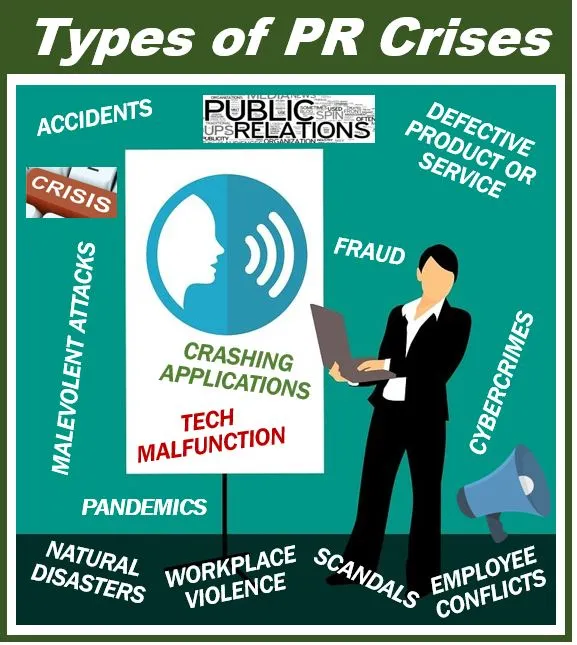Think you’re immune to a PR disaster? Think again. Are you certain that you’d be able to handle it if it ever happened?
Preparation and planning are essential when dealing with a potential PR crisis, just like any other critical company risk. In the face of a day you hope will never arrive, this is the best strategy for coping.
In the event of a PR disaster, responsible leadership should include crisis prevention, planning, and a cool, direct approach to communication.
The Basics of Crisis Communication
The goal of crisis communication is to reduce the likelihood of a disaster occurring. Action items that take into account the individual, the organization, and society are highlighted by De la Cierva. Among the most important things to do in a crisis are:
Focus on the impressions of others. There is a clear correlation between public perception of a crisis and the real events on the ground, rather than the other way around.
Pay attention to what the demonstrators have to say. It’s critical to investigate the root causes of people’s rage. As a result, the person you are speaking to will not be able to hear what you have to say unless they have first had their say.
Pay attention to your feelings. Understanding the mood of the general audience is an important skill. As a means of distributing ideas, communication should not be considered as an impersonal method of doing so.
Speak from the perspective of the other person. Make it apparent that the company is defending the interests of those it serves.
Identify the difference between the legislation and the opinions of the general public. In other words, you may be right but also wrong. With both legal and communications specialists on hand, you’ll be better prepared.
Always say the truth. Credibility is built on honesty. One of the worst things you can do in a time of stress is to fabricate your story.
Take responsibility for your actions. Take charge of your life. This may entail resolving the issue at hand, owning up to one’s errors, and making good on any harm done as a result.
Be ready. Officers in charge of crisis communication are expected to have a customer-focused mindset. For this, they must be able to communicate effectively in a straightforward, non-offensive way.
It’s crisis time!
Foresight, prevention, and provision are the three components of crisis preparedness. A company’s internal and external surroundings must be properly understood so that crises can be foreseen and their implications anticipated. Taking a proactive approach to avoid obvious catastrophes is called prevention. An action plan is necessary for provision.
Alternatively, a “crisis plan,” which is a sequence of rapid actions to be taken in response to each event, What about communication?
The first stage is to assemble a crisis management team to gather information, allocate duties, and determine the organization’s position regarding the issue. It’s all about planning ahead.
It is also part of the crisis team’s job to define the problem, determine who it will affect, and then decide what action the organization should take. Consider the possible outcomes as well as the current state of affairs.
Information must be gathered in a methodical manner in order to gain a better understanding of how the crisis has affected various groups. The company’s formal answer will be based on this data.
Select a spokesperson who is skilled at conveying the company’s message to the various groups affected and to the media in order to communicate this response. A spokesperson will be chosen according to the type and scope of the crisis (technical or personal), as well as how long it is projected to last. A spokesperson will be chosen that best fits the needs of the organization.
It’s time to choose the company’s communication channels after deciding on a message, a spokesman, and future steps. While these are the usual avenues for day-to-day communication, interactive tools like social media should take precedence for quick responses.
An all-encompassing strategy is also required. Employees should have access to the intranet via the company’s website to keep them up to date on corporate news and events. Press conferences and correspondence should be used to keep the media informed.
All of this hinges on the corporation taking the lead in communicating with its customers and other stakeholders. In order for it to become a trusted source, it must act proactively and creatively to control the scope of the problem and manage time. People’s needs should be taken into consideration when making updates.
What is the next step?
After completing an action plan, the results should be evaluated and documented. To ensure that the communications strategy is having the desired effect, it’s critical to keep tabs on the press and social media to see how it’s performing. There should be an overall assessment and a post-crisis plan agreed upon once the crisis is resolved.
Accounts and analyses of the crisis are essential for the future of the field’s work. However, in order for this knowledge to be put to use, internal changes must be made and implemented.
Crises pose a serious danger to an organization’s public relations. As a result, a company’s long-term viability hinges on its capacity to maintain strong ties with key stakeholders. When it comes to building the strongest possible connections, effective communication is absolutely critical.










